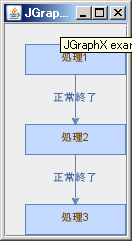GroovyとJGraphXを使用してフロー図を描画するには、以下のコードを実行します。
import javax.swing.*
import groovy.swing.*
import com.mxgraph.swing.*
import com.mxgraph.view.*
def graph = new mxGraph()
parent = graph.getDefaultParent()
graph.model.beginUpdate()
try
{
def v1 = graph.insertVertex(parent, null, "処理1",
20, 20, 100, 30)
def v2 = graph.insertVertex(parent, null, "処理2",
20, 100, 100, 30)
def v3 = graph.insertVertex(parent, null, "処理3",
20, 180, 100, 30)
graph.insertEdge(parent, null, "正常終了", v1, v2)
graph.insertEdge(parent, null, "正常終了", v2, v3)
}
finally
{
graph.model.endUpdate()
}
sb = new SwingBuilder()
sb.frame(
title: "JGraphX example1",
visible: true,
pack: true,
resizable: true,
defaultCloseOperation: WindowConstants.EXIT_ON_CLOSE
){
widget( new mxGraphComponent(graph) )
}
実行結果

関連情報
JGraphxのダウンロードページ
 関連情報
JGraphxのダウンロードページ
関連情報
JGraphxのダウンロードページ


